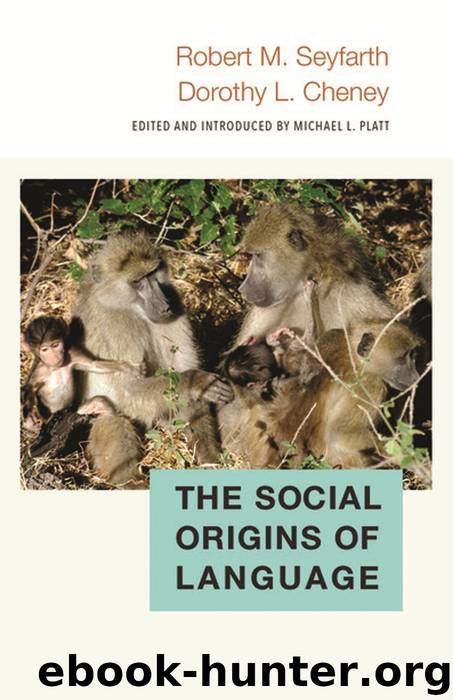The Social Origins of Language by The Social Origins of Language

Author:The Social Origins of Language [Language, The Social Origins of]
Language: eng
Format: epub
ISBN: 9780691177236
Publisher: Princeton University Press
Published: 2017-01-15T07:00:00+00:00
Figure 4. (A) The state transitions of a right branching, non-deterministic Artificial Grammar with several elements (A, C, D, F, G; nonsense words, see Wilson et al., 2013; 2015). The AG can generate sequences of variable length and composition. Following the arrows generates a legal sequence of transitions (check marks over legal transitions in B). Not following the arrows generates an illegal transition (x’s over the transitions in the illegal sequences in B).
Some studies have also seen differences in the level of AG sequencing complexity that different species are able to process, which provides some evidence for a gradation in sequence processing abilities. As mentioned above, tamarin monkeys (New World monkeys) and humans can both notice violations to adjacent, alternating AB relationships, while humans seem to be better at detecting more complex relationships in sequences of the form AAABBB (Fitch and Hauser 2004), including when there are explicit ordering relationships between particular A and B elements, as in A1 A2 B2 B1 (Bahlmann, Schubotz, and Friederici 2008; Udden et al. 2012). In other behavioral experiments, both rhesus macaques (Old World monkeys) and common marmosets (New World monkeys) notice certain violations of ordering relationships in sound sequences (Wilson et al. 2013). The marmosets appear to primarily notice violations in just the initial positions in the AG sequences (Wilson et al. 2013). However, the macaques and human participants also notice violations of adjacent relationships throughout these sequences of five to six elements (Wilson, Smith, and Petkov 2015). The AG that was used also contained nonadjacent relationships, which the macaques did not appear to notice and which only some of the humans were sensitive to, revealing both cross-species and within-species differences in sequence processing capabilities. Work with birds has also noted within species (van Heijningen et al. 2009) and across species (Spierings and ten Cate 2016; Stobbe et al. 2012) differences in avian AGL capabilities. Other gradations in animal abilities are being assessed in rodents and birds (e.g., Arriaga and Jarvis 2013; Petkov and Jarvis 2012; Feenders et al. 2008). For example, the impressive vocal imitation abilities of parrots in relation to songbirds appear to be supported by changes in neurobiological substrates. The parrot forebrain song nuclei have a core and shell organization, whereas songbirds appear to have only a core forebrain song nucleus (Chakraborty et al. 2015).
Other AGs have been designed to assess the learning of nonadjacent dependencies. For example, Newport and colleagues (2004) presented cotton-top tamarin monkeys (New World monkeys) with sequences of three syllables in which the first syllable predicted the final syllable, separated by an uninformative middle syllable. In a series of experiments, they showed that under a number of conditions the monkeys were sensitive to these nonadjacent relationships. Also, spider monkeys have been tested with sequences of high and low tones, matched to the animals’ naturally vocal frequencies (Ravignani et al. 2013). In this paradigm, legal sequences were required to begin and end with the same tone, separated by a number of tones at a different center frequency (e.
Download
This site does not store any files on its server. We only index and link to content provided by other sites. Please contact the content providers to delete copyright contents if any and email us, we'll remove relevant links or contents immediately.
Cecilia; Or, Memoirs of an Heiress — Volume 1 by Fanny Burney(32412)
Cecilia; Or, Memoirs of an Heiress — Volume 3 by Fanny Burney(31822)
Cecilia; Or, Memoirs of an Heiress — Volume 2 by Fanny Burney(31802)
The Lost Art of Listening by Michael P. Nichols(7388)
Asking the Right Questions: A Guide to Critical Thinking by M. Neil Browne & Stuart M. Keeley(5599)
We Need to Talk by Celeste Headlee(5522)
On Writing A Memoir of the Craft by Stephen King(4847)
Dialogue by Robert McKee(4305)
Pre-Suasion: A Revolutionary Way to Influence and Persuade by Robert Cialdini(4119)
I Have Something to Say: Mastering the Art of Public Speaking in an Age of Disconnection by John Bowe(3832)
Elements of Style 2017 by Richard De A'Morelli(3299)
The Book of Human Emotions by Tiffany Watt Smith(3221)
Fluent Forever: How to Learn Any Language Fast and Never Forget It by Gabriel Wyner(3011)
Name Book, The: Over 10,000 Names--Their Meanings, Origins, and Spiritual Significance by Astoria Dorothy(2926)
Good Humor, Bad Taste: A Sociology of the Joke by Kuipers Giselinde(2890)
Why I Write by George Orwell(2863)
The Art Of Deception by Kevin Mitnick(2721)
The Grammaring Guide to English Grammar with Exercises by Péter Simon(2698)
Ancient Worlds by Michael Scott(2607)
